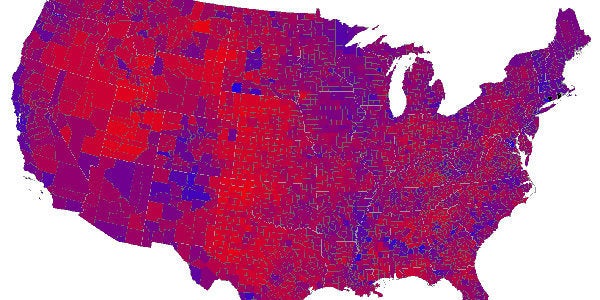
For months, a sense of dread has been percolating within Republican circles over potentially massive congressional losses in 2008. Facing the possibility of a more pronounced minority status in the House and more than a couple seats lost in the Senate, the GOP has begun setting its sights on a contingency plan: redistricting.
Republican officials now believe that the party's best hope for retaking seats in Congress may come during gubernatorial elections in 2010. Should the GOP win back the majority of these seats (Democrats currently occupy 28 state capitols), they would be extremely well positioned to influence the redistricting of the political map that will come after the 2010 census.
"The 2010 elections are almost as important or equally important as the elections this year. After redistricting in 2011, the governors are going to have a huge influence in determining the political makeup of this country," said Chris Schrimpf, a spokesman for the Republican Governors Association. "We could feasibly see 25 to 30 congressional seats swing as the result of redistricting. And the state legislatures and governor could determine that swing. Can the National Republican Congressional Committee make a statement like that with a straight face? It would be harder for them."
The suggestion that the elections of 2010 could be as important as those in 2008 may seem like hyperbole or distraction from a Republican Party bracing for big losses. But Democratic officials are also smarting to the premise. One insider, who described the idea as a "pretty sad reflection of the Republican Party's state of affairs," nevertheless conceded that it was on everyone's radar.
Brian Namey, spokesman for the Democratic Governors Association described Democratic governors as "a formidable line of defense against Republicans who would like to Tom DeLay us out of congressional seats."
An abundance of seats are in play. There will be 36 gubernatorial races in 2010, compared to 11 such elections this cycle. Of those 36, 19 are for state houses currently held by Democrats. And of those 19, ten will involve Democratic governors who won't be running for reelection (either because of term limits or retirement).
Because redistricting follows the 2010 census, each state will be reevaluating its congressional map in 2011. And in almost every one of these states, a tremendous amount of authority for this endeavor is placed in the governor's hands.
In 28 states, the governor has the authority to veto any redistricting plan. In eight separate states, the governor can veto only a congressional plan. In another five states, the governor is responsible for appointing members to the redistricting board. And in three states -- not separate -- the governor is directly involved in redrawing the district him or herself. In only eight states does the executive body actually not play a role. As both Democratic and Republican officials readily acknowledge, the partisan makeup of a newly shaped congressional district will almost certainly reflect the politics of the sitting governor.
"The odds are, if it is a Republican in the governor's chair, the seat will end up in GOP hands," said Schrimpf.
So what, exactly, are the stakes at play? Namey calculates that of the 36 gubernatorial races in 2010, 32 will involve governors who will impact their state's redistricting in some way or another.
Meanwhile, because of shifting populations, there is likely to be one more congressional seat added in Georgia, California, Nevada and Utah; possibly two more added in Florida and Arizona; and the chance of four more seats added in Texas. Every state on this list, except for Arizona, currently has a Republican governor. All but Utah will hold a gubernatorial election in 2010. If Republicans hold their power they will be well positioned.
Conversely, Illinois, Iowa, Louisiana, Massachusetts, Michigan, Missouri, and Pennsylvania all seem likely to lose a congressional seat as a result of diminishing populations. New York and Ohio could lose two. Every state on this list, except Missouri and Louisiana, is both run by a Democrat and will have a gubernatorial election in 2010.
Of course, in almost every state, the legislative chambers will have a say into how the congressional districts are re-drawn. And in this regard the governor's power is limited. Oftentimes, in fact, redistricting plans get sent to state courts to adjudicate disagreements.
In 2010, there will be more than 1,150 state senate races and more than 4,950 state house races held nationwide. Here, too, Democrats and Republicans are cognizant of any edge.
"A flip of 50 state seats in key chambers could mean a gain -- or a loss -- of 15 Democratic Congressional seats in the next round of redistricting," said Michael Sargeant, executive director of the Democratic Legislative Campaign Committee. "We need to continue winning statehouses so that we can be at the table when these district lines are drawn."
With all these elections coming at once, Republicans are clearly looking to the states as a golden opportunity to make national advances. And with a political brand that is, by their own accounts, poisonous, and with the odds currently favoring the possibility of a Democratic White House, the gubernatorial races of 2010 could very end up representing the GOP's lifeline.
"In the worst case scenario, 2010 would be the first, most important evidence that there is life in the Republican Party," said Craig Shirley, a longtime Republican strategist. "The elections that year will be vitally important because it will put on stage the worst creative skills of ever politician... Members of Congress aren't bright about handling Social Security, Medicare and the budget but they are astonishing bright at self-preservation... and drawing favorable [political] districts."
